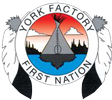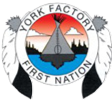“Water is the foundation of life. Our ancestors knew this, and it still is.”
 The York Factory First Nation Cree have lived with, travelled along, and relied on the waters of Northern Manitoba since time immemorial. Their homeland lies along the Hudson Bay coast, where settlements stretched from Ontario to Churchill, and in-land to Shamattawa and Gillam. The Cree became key actors in the North American fur trade from the 17th to 20th century, supporting and supplying the Hudson’s Bay Company’s Kichewaskahekan (‘big house’ or Fort York) in the core of their traditional territory.
The York Factory First Nation Cree have lived with, travelled along, and relied on the waters of Northern Manitoba since time immemorial. Their homeland lies along the Hudson Bay coast, where settlements stretched from Ontario to Churchill, and in-land to Shamattawa and Gillam. The Cree became key actors in the North American fur trade from the 17th to 20th century, supporting and supplying the Hudson’s Bay Company’s Kichewaskahekan (‘big house’ or Fort York) in the core of their traditional territory.
The York Factory First Nation (YFFN) signed an adhesion to Treaty #5 in 1910. When the Hudson’s Bay post at York Factory closed in 1957, York Factory First Nation members were relocated from their homeland, to a small site on the south east shore of Split Lake, which is now known as Kawechiwasik, or York Landing.
Since the relocation, YFFN has experienced the effects of the Kelsey Generating Station, Lake Winnipeg Regulation, Churchill River Diversion, and other hydro-electric developments in the region.
In 2001, YFFN was approached to join the planning and partnership negotiations for the Keeyask Project. Following 8 years of negotiations, and a referendum by its members, YFFN chose to become a Limited Partner in the Keeyask Generating Station Project.
Now, for the first time, YFFN is party to a hydro-electric development project, and to the changes that it will bring to local communities, waters, lands and wildlife. As project partners, YFFN members emphasize the importance of proceeding in a cautious and responsible manner; of respecting Cree values and teachings; and ensuring that the project leaves a positive legacy for future generations.
Governance:
Chief Darryl K. Wastesicoot
Councillor George Beardy
Councillor Wayne Redhead
Councillor Louisa Constant
Councillor Frank Wastesicoot
“Our ancestors have always been keepers of the land. Destruction was never part of it. Things have changed now and we have to change too – but we need to keep these teachings of the elders.”
“We are making a decision to be part of a development that our children will not be able to undo. They will inherit this project and our land with this project in it.”
“What I want most is something for the future. If I don’t have anything today, I can live with that. I can’t live with not leaving anything for the future.”






